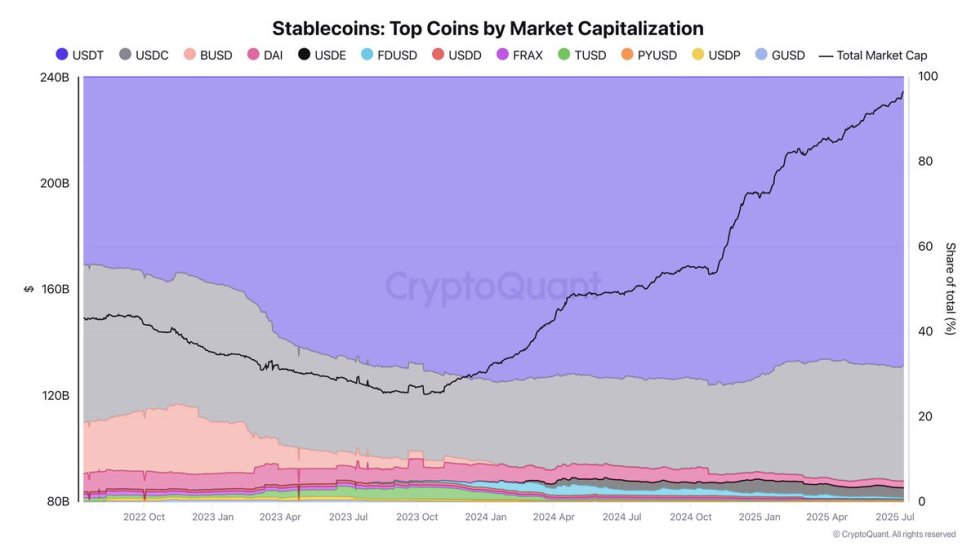Move over Bitcoin, there’s a new sheriff in town and it’s called Stablecoins! These digital assets have been causing quite a stir in the crypto market, with a whopping $235 billion market cap. That’s right, folks, stablecoins are the fastest-growing sector in the crypto world since the beginning of this cycle.
Not only are they playing a critical role in driving liquidity, market stability, and cross-border transactions, but they’ve also become the life of the party during this week’s “Crypto Week” in Washington. US lawmakers are currently reviewing the Genius Act, a pivotal bill aimed at defining the legal framework for stablecoins in the United States. 🤑
Meanwhile, Tether (USDT) continues to dominate the stablecoin landscape, commanding 68% of the market share. USD Coin (USDC) follows with 27%, while newer entrants like USDE hold 2.2%. Binance‘s BUSD now trails at just 1.5%, reflecting its gradual phase-out. 💸
Stablecoins: The Liquidity Engine of Crypto World
Top analyst Darkfost has highlighted a critical development in the crypto market: the total market cap of stablecoins has now climbed to $235 billion. This steady increase is more than just a number—it’s a clear signal that liquidity continues to flow into the digital asset space, even as prices experience short-term volatility. The rising stablecoin supply suggests that capital is being parked on-chain, ready to deploy across trading, DeFi, and institutional strategies.

Stablecoins have become the primary liquidity engine behind Bitcoin and the broader crypto market. Their utility as dollar-pegged, low-volatility assets makes them ideal for trading, hedging, and transferring value without relying on traditional banks. In essence, they are the bridge between traditional finance and crypto—connecting centralized capital with decentralized infrastructure.
With “Crypto Week” underway in Washington, stablecoins are under the spotlight. US legislators are expected to make critical decisions that could shape the way these assets function within both the crypto space and the traditional financial system. If regulators move toward supportive and well-defined guidelines, adoption and issuance could accelerate rapidly.
Analysts expect that legal clarity around stablecoins will not only boost investor confidence but also open the door for more institutional participation. Given their central role in liquidity flows, any positive outcome from this week’s debates could fuel the next wave of capital entering crypto markets—solidifying stablecoins as essential infrastructure for the digital economy. As liquidity builds, the groundwork for a broader market expansion continues to strengthen.
Dominance Holds at 7.28% as Market Liquidity Builds
The weekly chart of stablecoin dominance shows that they currently account for 7.28% of the total crypto market, a level that has held relatively steady in recent months. Despite the recent surge in total market cap to $235 billion, dominance has remained within a sideways range, suggesting that liquidity is flowing into both stablecoins and crypto assets simultaneously—rather than moving defensively into stables as seen during previous bear cycles.

Notably, the chart shows dominance falling below all major moving averages: the 50-week (7.73%), 100-week (7.97%), and 200-week (9.31%) SMAs. This suggests that while stablecoin issuance is rising in absolute terms, its share of total market value is shrinking as Bitcoin and altcoins outperform. This is typically seen during early to mid-stage bull markets, when capital begins rotating from stablecoins into risk-on assets.
Historically, sharp spikes in dominance have coincided with periods of market stress, while declines have marked expansion phases. The current stability around 7% reflects a balanced environment where liquidity remains available, but market participants are comfortable holding volatile assets.
Read More
- Clash Royale Best Boss Bandit Champion decks
- Clash Royale December 2025: Events, Challenges, Tournaments, and Rewards
- Ireland, Spain and more countries withdraw from Eurovision Song Contest 2026
- Clash Royale Witch Evolution best decks guide
- Mobile Legends December 2025 Leaks: Upcoming new skins, heroes, events and more
- Clash Royale Furnace Evolution best decks guide
- Mobile Legends X SpongeBob Collab Skins: All MLBB skins, prices and availability
- Football Manager 26 marks a historic FIFA partnership ahead of its November launch
- The Most Underrated ’90s Game Has the Best Gameplay in Video Game History
- JoJo’s Bizarre Adventure: Ora Ora Overdrive unites iconic characters in a sim RPG, launching on mobile this fall
2025-07-15 21:43